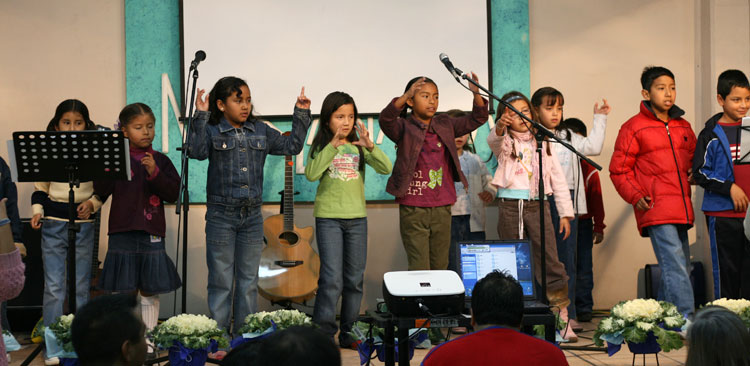Steve Kriss
skriss@mosaicmennonites.org
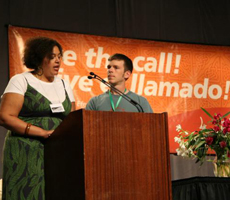 We had a good time together in California, the 6,000 or so Mennonites who gathered at San Jose 2007. Youth sang hymns late into the night on the city’s efficient light rail. We heard new Mennonites like Phoenix pastor Shane Hipps tell his story of becoming Anabaptist first in the head, then in the heart. Brother George Makinto from Los Angeles lead the adults with grace and ease in multilingual worship. A team from Eastern Mennonite University produced creative and high quality video for youth and adults all week. It was a time of hopeful interaction.
We had a good time together in California, the 6,000 or so Mennonites who gathered at San Jose 2007. Youth sang hymns late into the night on the city’s efficient light rail. We heard new Mennonites like Phoenix pastor Shane Hipps tell his story of becoming Anabaptist first in the head, then in the heart. Brother George Makinto from Los Angeles lead the adults with grace and ease in multilingual worship. A team from Eastern Mennonite University produced creative and high quality video for youth and adults all week. It was a time of hopeful interaction.
But it was also a sobering week. I was struck by how many of us were white with gray hair. I was the youngest of the ten who sat at my round delegate table. While there were reportedly more young adults present than ever before, I wondered in the midst of our discussion what kind of future our church might have when the average Mennonite is 54 years old. As experienced leaders (all old enough to be my parents and with the departure of moderator Roy Williams, all EuroAmerican and from the Midwest) navigated our delegate discernment, Jim Schrag called for an audacious church. It was a buzzword that sounded more like the word choice of a California surfer than our staid MC USA executive director and it caught the attention of the delegates. What would it take to be an audacious church?
Audacity suggests both boldness and an element of surprise. In listening to Conrad Kanagy’s report about Mennonite Church USA demographics at San Jose, we need to recognize that the research suggests a serious decline. To find a hopeful future, we’ll need to make audacious choices that recognize two things that we heard at San Jose 2007—the rapid growth of African American, African, Asian and Latino congregations and the loss of young adults within the church as a whole.
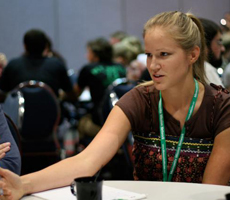 The anti-racism reports from denominational agencies thinly mask the embarrassing realities of racial/ethnic tokenism within most of our institutions. Young leaders frequently find themselves on the margins of engagement and decision-making even when present at the table. I am convinced that by opening the church and its institutions beyond token additive presence to persons under 30 and racial/ethnic leaders, we’d find surprising new structures that lean toward relevance, sustainability, and flourishing. We need the creative audacity of those leaders to transform our ways of doing and being into a real future. We need those transformative insights now, not in a decade after the average Mennonite Church USA member is over 65.
The anti-racism reports from denominational agencies thinly mask the embarrassing realities of racial/ethnic tokenism within most of our institutions. Young leaders frequently find themselves on the margins of engagement and decision-making even when present at the table. I am convinced that by opening the church and its institutions beyond token additive presence to persons under 30 and racial/ethnic leaders, we’d find surprising new structures that lean toward relevance, sustainability, and flourishing. We need the creative audacity of those leaders to transform our ways of doing and being into a real future. We need those transformative insights now, not in a decade after the average Mennonite Church USA member is over 65.
I have seen the capacity of audacious leaders. From Philadelphia where my colleague Aldo Siahaan was amazed at what it felt to be part of the larger Mennonite Church USA community for the first time while bridging Anabaptist values to Indonesian immigrants at San Jose, to the call from mostly urban leaders who desire an end to disciplining and expelling congregations because of dissonance with the Confession of Faith in a Mennonite Perspective to San Jose Junior High conventioners who raised $4000 to share with Anabaptists in the Congo.
Audacity assumes that our future begins now, not tomorrow. Our future is not small-town homogeneity but increasing heterogeneity in familiar places as well as vibrant Anabaptist visions from the coasts, borders, and cities. Our lack of recognition of this heterogeneity is already embarrassing. Inadequate language translation as was the case at San Jose 2007 marks us as ill-prepared for the present as well as the future. Reading Scripture and singing occasionally in other languages is not enough to move into our heterogeneous future. We’ll need to be more intentional about how we include those among us who speak not only Spanish but Chinese, Arabic, Korean, Indonesian, Garifuna, French, Vietnamese, Hmong, Cherokee, German, and Amharic.
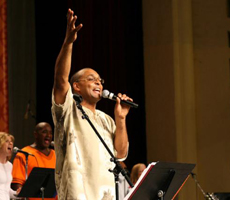 Audacity within our denominational structures involves the risk of confronting the limitations of continuing administrative activity from Elkhart and Newton. I cringe at the realization that it seems we’ve already embraced a future for our denomination in which we’re working mostly from small cities in the Midwest, ignoring early MC USA transformation commitments to bi-coastal presences. Have we deemed coastal locations too expensive without counting the costs of a future that ignores urban, multi-ethnic, bi-coastal realities?
Audacity within our denominational structures involves the risk of confronting the limitations of continuing administrative activity from Elkhart and Newton. I cringe at the realization that it seems we’ve already embraced a future for our denomination in which we’re working mostly from small cities in the Midwest, ignoring early MC USA transformation commitments to bi-coastal presences. Have we deemed coastal locations too expensive without counting the costs of a future that ignores urban, multi-ethnic, bi-coastal realities?
Mennonite Church USA institutions are largely bound to tradition and practice that seemingly ignores the deductions of Kanagy’s report. We’re too often stuck asking increasingly irrelevant questions like whether persons are from MC or GC congregations or living in fear of the possibilities of diminished human resources and capital. We make safe, inaudacious choices. Audacity suggests a sense of fearlessness that we don’t often gird ourselves with as process and consensus oriented Mennonites.
At San Jose 2007, we heard good stories and witnessed some difficult facts. These stories and facts suggest both deep needs and wonderful possibilities. I don’t want to incite a doomsaying fear, but invite us to recognize the dream of audacity that we glimpsed in California together. Do we have the courage and wherewithal to be shaped and reshaped by young leaders and leaders from our growing racial/ethnic community? The future of our church depends on this willingness to be transformed now beyond the difficult institutional shuffling that has been our merged denominational history and into new generations and new representations of what it means to boldly live out our calling. Viva el llamado.
Photos by David Landis

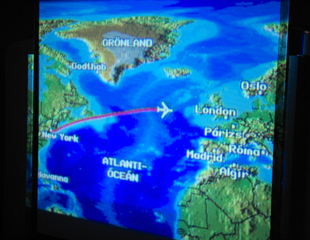 Today we finally arrived in Israel. We experienced God’s favor and traveling mercy. There were a lot of things that could have slowed us down but didn’t. The most challenging leg of our journey was the flight from JFK airport to Budapest. The air quality and cramptness proved tested the limits of my mental facualties. We were re leaved to rendezvous with our leader
Today we finally arrived in Israel. We experienced God’s favor and traveling mercy. There were a lot of things that could have slowed us down but didn’t. The most challenging leg of our journey was the flight from JFK airport to Budapest. The air quality and cramptness proved tested the limits of my mental facualties. We were re leaved to rendezvous with our leader 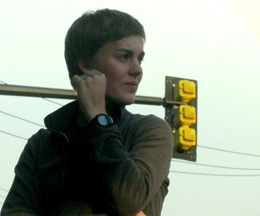 As our rental mini-van approached the Twin Cities, Steve Kriss turned down the radio and raised his voice a few notches so those of us curled up in the back seat could hear. Steve, Jessica Walter, Ale Lopez, Felicia Moore, Sheldon Good, and I had driven for two days, as we kicked-off a week long Midwest road trip. Steve offered a reminder of the purpose of our trip before we pulled into our first official destination. I was surprised when he started talking about the early church, thinking to myself how driving cross-country with our iPods, laptops, and gas station stops related to the early Christian church. But as Steve began telling the story of those early churches that spread quickly and sprang up all over the Roman empire, I felt some of Steve’s excitement and understood his comparisons.
As our rental mini-van approached the Twin Cities, Steve Kriss turned down the radio and raised his voice a few notches so those of us curled up in the back seat could hear. Steve, Jessica Walter, Ale Lopez, Felicia Moore, Sheldon Good, and I had driven for two days, as we kicked-off a week long Midwest road trip. Steve offered a reminder of the purpose of our trip before we pulled into our first official destination. I was surprised when he started talking about the early church, thinking to myself how driving cross-country with our iPods, laptops, and gas station stops related to the early Christian church. But as Steve began telling the story of those early churches that spread quickly and sprang up all over the Roman empire, I felt some of Steve’s excitement and understood his comparisons.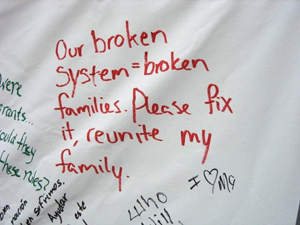 These questions were unsettling, to say the least. Throughout my college years, I have come to believe deeply in a God who crosses all boundaries and whose Spirit is active and present in the world; I have found faith in the life, death, and resurrection of Jesus Christ, trusting that he provides salvation from the cycles of violence of our world and enables every one of us to find healing and wholeness amidst our brokenness. I began to wonder: what if these beliefs were only relevant in a community I was at ease in? What happened if faith and salvation only worked and felt right when I was surrounded by people who came from the same place as me, articulated their theology similarly, worshiped in ways I enjoyed and connected with? I always thought I embraced diversity, but what if deep down I wanted everyone to be the same kind of Christian and same kind of Mennonite that I am?
These questions were unsettling, to say the least. Throughout my college years, I have come to believe deeply in a God who crosses all boundaries and whose Spirit is active and present in the world; I have found faith in the life, death, and resurrection of Jesus Christ, trusting that he provides salvation from the cycles of violence of our world and enables every one of us to find healing and wholeness amidst our brokenness. I began to wonder: what if these beliefs were only relevant in a community I was at ease in? What happened if faith and salvation only worked and felt right when I was surrounded by people who came from the same place as me, articulated their theology similarly, worshiped in ways I enjoyed and connected with? I always thought I embraced diversity, but what if deep down I wanted everyone to be the same kind of Christian and same kind of Mennonite that I am? Each congregation we visited connected with the Anabaptist tradition and Mennonite church, and each expressed this connection in different ways. None was perfect but each taught me or reminded me of something of great value. Missio Dei is excited by the radical nature of the early Anabaptist movement and by the strong focus Anabaptists/Mennonites place on scripture and the teachings of Christ. They reminded me that it is possible to live our faith radically and that many times the words of Christ lead us to radical action. The Christ Community congregation of Des Moines focused strongly on bridging the gap between academic theology and the life of the congregation, which gave me some exciting ideas for how congregations can begin developing and articulating their theologies. Pastor Jane Buller, who met with our group at Walnut Hill, spoke of how a space was made for her to enter into leadership, reminding me that there is a place for me in this church that I claim as my own.
Each congregation we visited connected with the Anabaptist tradition and Mennonite church, and each expressed this connection in different ways. None was perfect but each taught me or reminded me of something of great value. Missio Dei is excited by the radical nature of the early Anabaptist movement and by the strong focus Anabaptists/Mennonites place on scripture and the teachings of Christ. They reminded me that it is possible to live our faith radically and that many times the words of Christ lead us to radical action. The Christ Community congregation of Des Moines focused strongly on bridging the gap between academic theology and the life of the congregation, which gave me some exciting ideas for how congregations can begin developing and articulating their theologies. Pastor Jane Buller, who met with our group at Walnut Hill, spoke of how a space was made for her to enter into leadership, reminding me that there is a place for me in this church that I claim as my own. These snapshots have literally kept me awake at night for the last weeks, wondering and imagining how we might get there and yet knowing that we’re already on the road whether we admit it or not. It’s a future that excites me and forces me to think and rethink, to struggle and embrace the moments of hope that manifest along the way. It’s a future that in many ways is already here.
These snapshots have literally kept me awake at night for the last weeks, wondering and imagining how we might get there and yet knowing that we’re already on the road whether we admit it or not. It’s a future that excites me and forces me to think and rethink, to struggle and embrace the moments of hope that manifest along the way. It’s a future that in many ways is already here. The future will include a struggle for traditional EuroAmerican Mennonites to embrace possibilities, responsibilities and roles. It’s an ongoing struggle for me and for many young EuroAmerican leaders to understand what to do with power and privilege and how to consider empowerment and solidarity. Who are we in this global age if we are anything more than an ethnicity? What does it mean to live Anabaptist Mennonite values in urban contexts with extreme disparities? Why is it that our orientation toward justice and peacemaking is pacified by suburban lifestyles and wealth? What does it mean to have the ability to speak to the powers and to shape decisions that affect not only those in our own country but the globe? What happens when the majority of Mennonites no longer represent my own cultural preferences or biases? These were the kind of questions that are emerging for young adults who are serving with Mennonite Voluntary Service in Washington and studying and seeking at EMU. What does it mean to be a daughter or son of privilege? The future will require EuroAmericans to navigate a new way that blends what we know of the past into current and yet unfolding realities. The future will likely require EuroAmericans to ask more questions and to offer fewer quick answers or solutions.
The future will include a struggle for traditional EuroAmerican Mennonites to embrace possibilities, responsibilities and roles. It’s an ongoing struggle for me and for many young EuroAmerican leaders to understand what to do with power and privilege and how to consider empowerment and solidarity. Who are we in this global age if we are anything more than an ethnicity? What does it mean to live Anabaptist Mennonite values in urban contexts with extreme disparities? Why is it that our orientation toward justice and peacemaking is pacified by suburban lifestyles and wealth? What does it mean to have the ability to speak to the powers and to shape decisions that affect not only those in our own country but the globe? What happens when the majority of Mennonites no longer represent my own cultural preferences or biases? These were the kind of questions that are emerging for young adults who are serving with Mennonite Voluntary Service in Washington and studying and seeking at EMU. What does it mean to be a daughter or son of privilege? The future will require EuroAmericans to navigate a new way that blends what we know of the past into current and yet unfolding realities. The future will likely require EuroAmericans to ask more questions and to offer fewer quick answers or solutions.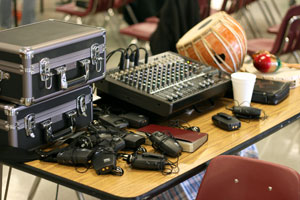 The music at New Hope was sung in English and Spanish that was led by a multiethnic team that included a French speaking African. There was translation. There was back and forth discussion between the congregation and Pastor Kirk Hanger, sometimes in English, sometimes in Spanish. The sermon featured interpretation of the Good News and the difference between good history and good news is its relevancy for the day. Pastor Kirk serves essentially to translate in many ways between the cultures and between the text and the time. The future will include translation sometimes by headset, sometime by incarnation, sometimes by words. We’ll learn to speak in ways that bridge cultures and work past presumptions.
The music at New Hope was sung in English and Spanish that was led by a multiethnic team that included a French speaking African. There was translation. There was back and forth discussion between the congregation and Pastor Kirk Hanger, sometimes in English, sometimes in Spanish. The sermon featured interpretation of the Good News and the difference between good history and good news is its relevancy for the day. Pastor Kirk serves essentially to translate in many ways between the cultures and between the text and the time. The future will include translation sometimes by headset, sometime by incarnation, sometimes by words. We’ll learn to speak in ways that bridge cultures and work past presumptions.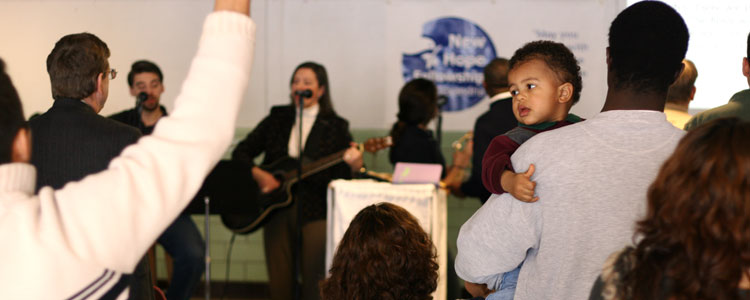
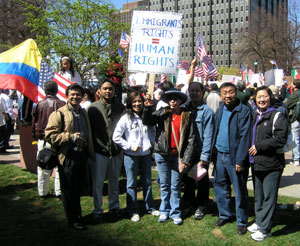 I’m working with the fourth immigration case that has taken me to an office in a building overlooking the mall between the National Constitution Museum and Independence Hall. On my last visit, the receptionist remembered that I had been in the office on my birthday. We went back to the counsel office and I listened as another immigrant who is part of a Franconia Conference congregation tell her story. I promised the lawyer that I accompany only complicated cases. He agreed.
I’m working with the fourth immigration case that has taken me to an office in a building overlooking the mall between the National Constitution Museum and Independence Hall. On my last visit, the receptionist remembered that I had been in the office on my birthday. We went back to the counsel office and I listened as another immigrant who is part of a Franconia Conference congregation tell her story. I promised the lawyer that I accompany only complicated cases. He agreed.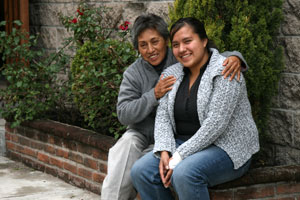 A Mennonite Central Committee worker recently suggested that Mennonites are good at cleaning up after messes, but less willing to figure out why we keep getting into them. Now into my fourth accompaniment situation for immigrants who are part of our congregations, I am compelled to respond differently to this situation. Sure, I can keep sitting in on these interviews and spend all of the birthdays of the rest of my life listening to the awkward situations and quagmires of process that are immigration realities. However, I am not content to continue accompanying our sisters and brothers to Center City law offices or to suggest that the situation is so complex that we can’t begin to address it in real ways either.
A Mennonite Central Committee worker recently suggested that Mennonites are good at cleaning up after messes, but less willing to figure out why we keep getting into them. Now into my fourth accompaniment situation for immigrants who are part of our congregations, I am compelled to respond differently to this situation. Sure, I can keep sitting in on these interviews and spend all of the birthdays of the rest of my life listening to the awkward situations and quagmires of process that are immigration realities. However, I am not content to continue accompanying our sisters and brothers to Center City law offices or to suggest that the situation is so complex that we can’t begin to address it in real ways either.